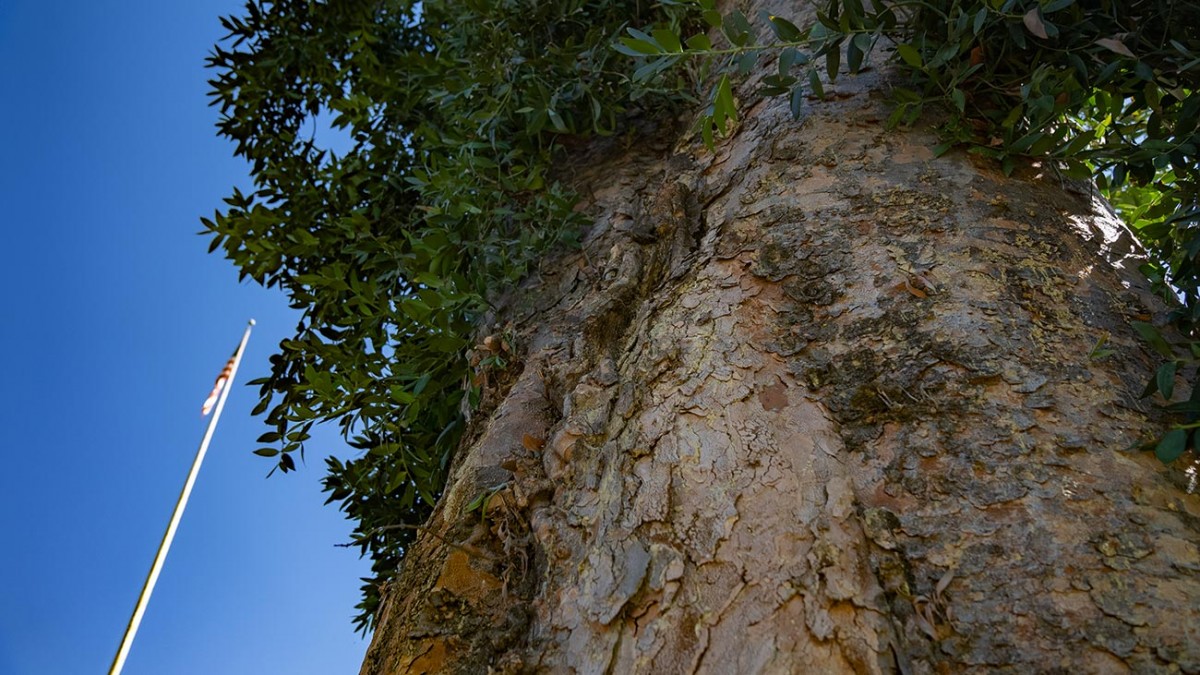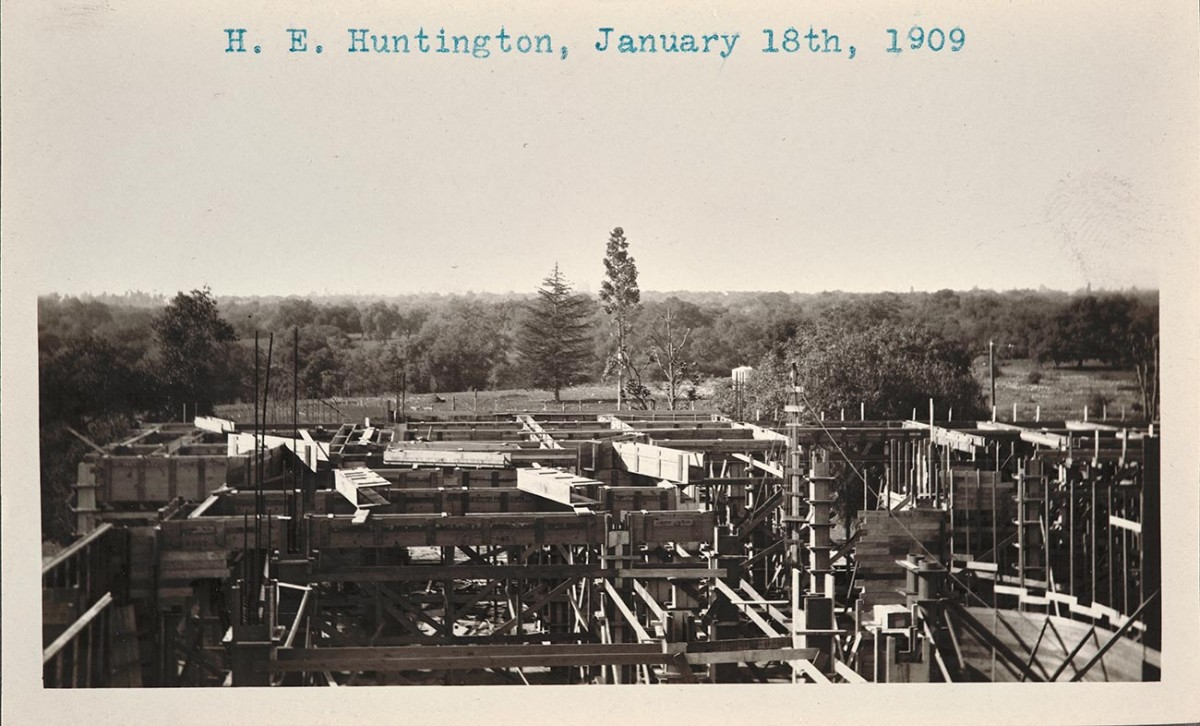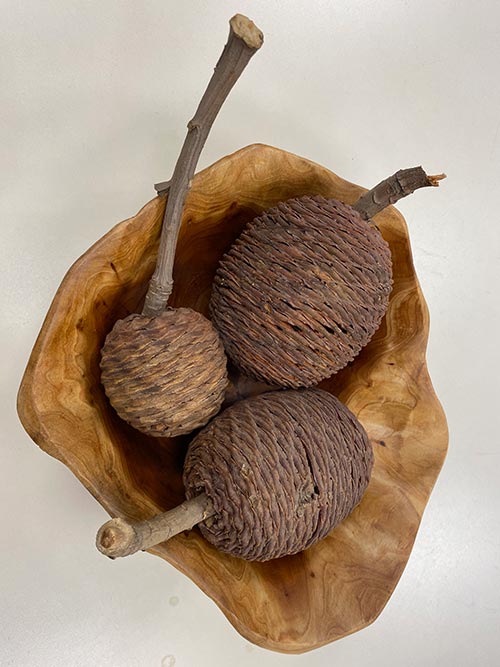The Huntington’s blog takes you behind the scenes for a scholarly view of the collections.
Seeing the Forest for the Trees
Posted on Wed., Nov. 24, 2021 by

This 131-year-old Queensland kauri (Agathis robusta), towering above the Rose Garden, is the oldest planted tree at The Huntington. (Some of the site-native oaks are older.) On Sept. 24, 2021, the tree was measured at 112 feet tall with a 27.5-foot average crown spread and 235-inch trunk circumference, earning it a designation as a California Big Tree, The Huntington’s first such honor. Photo by Aric Allen.
Among the largest and oldest organisms on Earth, trees are living time capsules in whose tissues are recorded epochs of changing climate, natural disasters, and the activities of the creatures around them. They are essential to the health of our planet, mitigating the influence of human activity—from sequestering carbon to moderating urban heat islands. Trees filter pollutants from the air, prevent erosion, shade and cool homes, and anchor wild habitats around the world.
The results of a five-year global tree assessment published earlier this year by Botanic Gardens Conservation International, whose U.S. office is based at The Huntington, determined that 30% of all tree species are in danger of extinction. The main threats are deforestation and other forms of habitat loss, direct exploitation for timber and other products, and the spread of invasive pests and diseases. Accelerated climate change is also having a measurable impact. Using its resources to support tree conservation is a priority at The Huntington, where trees have always been a valued component of the plant collections.

This 1909 photo shows the Queensland kauri, the tallest tree in the center of the photo, after its relocation during the construction of the Huntington residence, which would later become the Huntington Art Gallery. Huntington Library, Art Museum, and Botanical Gardens.
Even before Henry E. Huntington purchased the institution’s current site from its previous owner, James DeBarth Shorb, in 1903, native trees were abundant, most notably coast live oak (Quercus agrifolia) and Engelmann oak (Q. engelmannii), also known as Pasadena oak. Once widespread in the San Gabriel Valley, the latter has been nearly extirpated by development in this northernmost part of its small, scattered range and is considered one of California’s most endangered oaks. Huntington himself loved oaks and took great care to preserve them, and they remain a prominent feature in the gardens’ landscapes, whether planted by staff or by the birds and squirrels that the trees help support.
Today, The Huntington’s plant collections include some 800 tree species, both California natives and representatives of habitats around the world. With the gardens having passed the century mark, many old and large trees have origins that date back to the beginning of Henry Huntington’s stewardship. Few records were kept in the earliest years of the gardens, but one specimen has lived a well-documented existence: a giant that has witnessed the entire history of The Huntington and more.

The appearance of kauri cones inspired the first part of its scientific name, Agathis robusta. “Agathis” comes from Greek and means “a ball of twine.” Photo by John Trager.
This sentinel, a Queensland kauri (Agathis robusta), was planted in 1890 next to the Shorb family home, which was situated where the Huntington Art Gallery now stands. In 1908, when construction of the Huntington mansion (which would later become the Art Gallery) began, the decision was made to move the tree to its present location in the Rose Garden. It was already 40 feet tall, and, according to Huntington’s ranch superintendent William Hertrich, “presented a peculiar problem in transplanting: it had very few side roots but a long tap root seven inches in diameter.”
Hertrich described the details of dislodging the tree: “We were obliged to cut this tap root five feet below the ground’s surface, and then we seared the cut with a plumber’s blowtorch to stop the bleeding. I was skeptical about the success of moving this tree, but it turned out satisfactorily and is still growing.”
Satisfactorily, indeed! Fast-forward to Sept. 24, 2021, when the tree was measured at 112 feet tall with a 27.5-foot average crown spread and 235-inch trunk circumference, earning it a designation as a California Big Tree, The Huntington’s first such honor. On Nov. 5, Matt Ritter, professor of botany at California Polytechnic State University, San Luis Obispo, who serves as the coordinator for the California Big Tree Registry, paid a visit to The Huntington for a ceremony to officially certify the tree’s status as the largest Queensland kauri in the state. When answering a question about why we should care about big trees, Ritter replied, “We as humans like records . . . like ‘the biggest individual [of its kind].’ But what it becomes is a gateway drug to caring more about trees. And that’s important. Caring more about trees can ultimately lead to people having more of a conservation ethic associated with both urban forests and with native forests.”

Wild populations of kauris growing in stands tend to self-prune, dropping their lower branches. Their trunks may be free of branches for up to two-thirds of their total height. When growing in the open or in cultivation, the trees are typically tall and columnar and retain their branches down to the ground. Photo by Sean Lahmeyer.
Several offspring of the Rose Garden’s Queensland kauri can be found on The Huntington’s grounds, notably on the lawn downhill from the 1919 Cafe. These and others are part of the living legacy of Henry Huntington’s belief in the value of trees, an outlook that is taking on a new sense of urgency in this era of dwindling biodiversity and increasing impacts due to climate change. Tree conservation requires a long-range perspective and inspires a sense that things can change for the better. By sparking interest in the treasured trees in our collections and an appreciation for trees generally, The Huntington is investing in the possibility of a brighter future for generations to come.
As ornamental trees, kauris grow too large to serve well as street or home garden trees, but the ample grounds of The Huntington accommodate several kauris, all progeny of this original. Video by Aric Allen.
Kathy Musial is the curator of living collections at The Huntington.